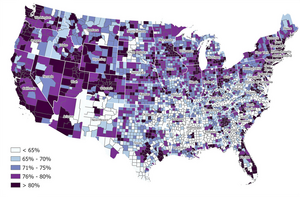Bridging the digital divide is crucial to promoting health equity as telehealth and online health services become increasingly vital to healthcare. A study by the University of Cincinnati found that the lack of broadband access in socially vulnerable communities is a significant barrier to healthcare access. Although the COVID-19 pandemic accelerated the adoption of telehealth, policies and programs are needed to increase access to these services in vulnerable communities to reduce healthcare disparities. The lack of per capita wireless coverage in the United States is largely due to its size, but the study found that the lack of broadband access in socially vulnerable communities can act as an institutionalized inequity that needs to be addressed to help vulnerable communities. Diego Cuadros, a study author and UC epidemiologist, emphasized that technology is here to stay, and these technologies are how we will experience a lot of aspects of our life, including healthcare. Claudia Moreno, a University of Washington assistant professor of physiology and biophysics, emphasized the need to create policies and programs that increase access to telehealth and broadband internet in vulnerable communities to exploit the potential of telehealth.
Bridging the Gap: Addressing Health Care Disparities through Broadband Internet
In rural parts of America, access to healthcare and high-speed internet remains limited, according to a recent study by the University of Cincinnati. The study identified disparities in access to digital technology that could widen the gap in access to healthcare, as socially vulnerable communities in the United States have less access to high-speed internet and fewer healthcare resources.
Presented at the American Association of Geographers’ annual conference in Denver, the study conducted a county-level data visualization and spatial analyses to assess the geospatial association between digital disparities and healthcare in the contiguous United States. The study found that patients require access to high-speed internet, computers, or smartphones and familiarity with technology to use telemedicine and online health services comfortably.
The COVID-19 pandemic accelerated the use of telemedicine and online health services, leading to a growing gap in access to healthcare. The Biden Administration announced an investment of $73 million in outreach grants this month to provide affordable high-speed internet to more Americans. The program aims to address the increasing gap in access to healthcare, especially in areas with limited broadband internet coverage.
Although telehealth is a useful tool for individuals with easy access to healthcare, it may not be as effective for individuals with limited access. Furthermore, the digital divide is likely to grow as we become more reliant on technology in the future. Diego Cuadros, a study author and UC epidemiologist, stated, “The point is telehealth is not going to be useful to everybody. It will be extremely useful to people who already have good access to healthcare, but it’s not going to be very useful to those who don’t.”
Cuadros collaborated with University of Washington assistant professor of physiology and biophysics Claudia Moreno to conduct the study. Cuadros runs UC’s Digital Epidemiology Laboratory and has previously researched disparities in easy access to healthcare across the United States, many of which are found in areas with limited access to digital technology such as high-speed internet.
In conclusion, the study by the University of Cincinnati highlights the need to bridge the gap in access to healthcare by addressing the digital divide in rural parts of America. As technology becomes increasingly vital to healthcare, it is crucial to ensure that socially vulnerable communities have access to high-speed internet, computers, and smartphones to take advantage of telemedicine and online health services. The investment in outreach grants is a step towards achieving this goal and reducing healthcare disparities.
Bridging the Digital Divide to Promote Health Equity
According to a 2023 Statista survey, the United States does not even make the top 20 nations in terms of per capita wireless coverage. The large size of the country in square miles is largely responsible for this. However, a study by the University of Cincinnati found that the lack of broadband access in socially vulnerable communities is a significant barrier to healthcare access.
The COVID-19 pandemic served as a catalyst for the adoption of new ways of doing things, including telehealth and online health services. While telehealth has the potential to help vulnerable communities, it is challenging for those who are not digitally literate or who do not own a smartphone or computer to access it. As a result, policies and programs are needed to increase access to healthcare in these communities.
Diego Cuadros, a study author and UC epidemiologist, noted that the pandemic was a tipping point for the adoption of technology in various aspects of life, from education to healthcare. He emphasized that these technologies are here to stay.
Claudia Moreno, a University of Washington assistant professor of physiology and biophysics who collaborated on the study, was surprised to see the strong correlation between the lack of broadband access and the socioeconomic and healthcare vulnerability of some regions. She suggested that broadband coverage can act as an institutionalized inequity that needs to be addressed to help vulnerable communities.
In conclusion, bridging the digital divide is crucial to promoting health equity. The lack of broadband access in socially vulnerable communities is a significant barrier to healthcare access, especially as telehealth and online health services become increasingly vital to healthcare. Policies and programs are needed to increase access to these services in vulnerable communities to reduce healthcare disparities.
Don’t miss interesting posts on Famousbio
